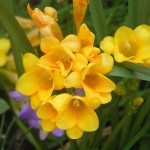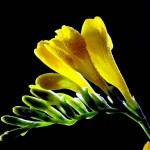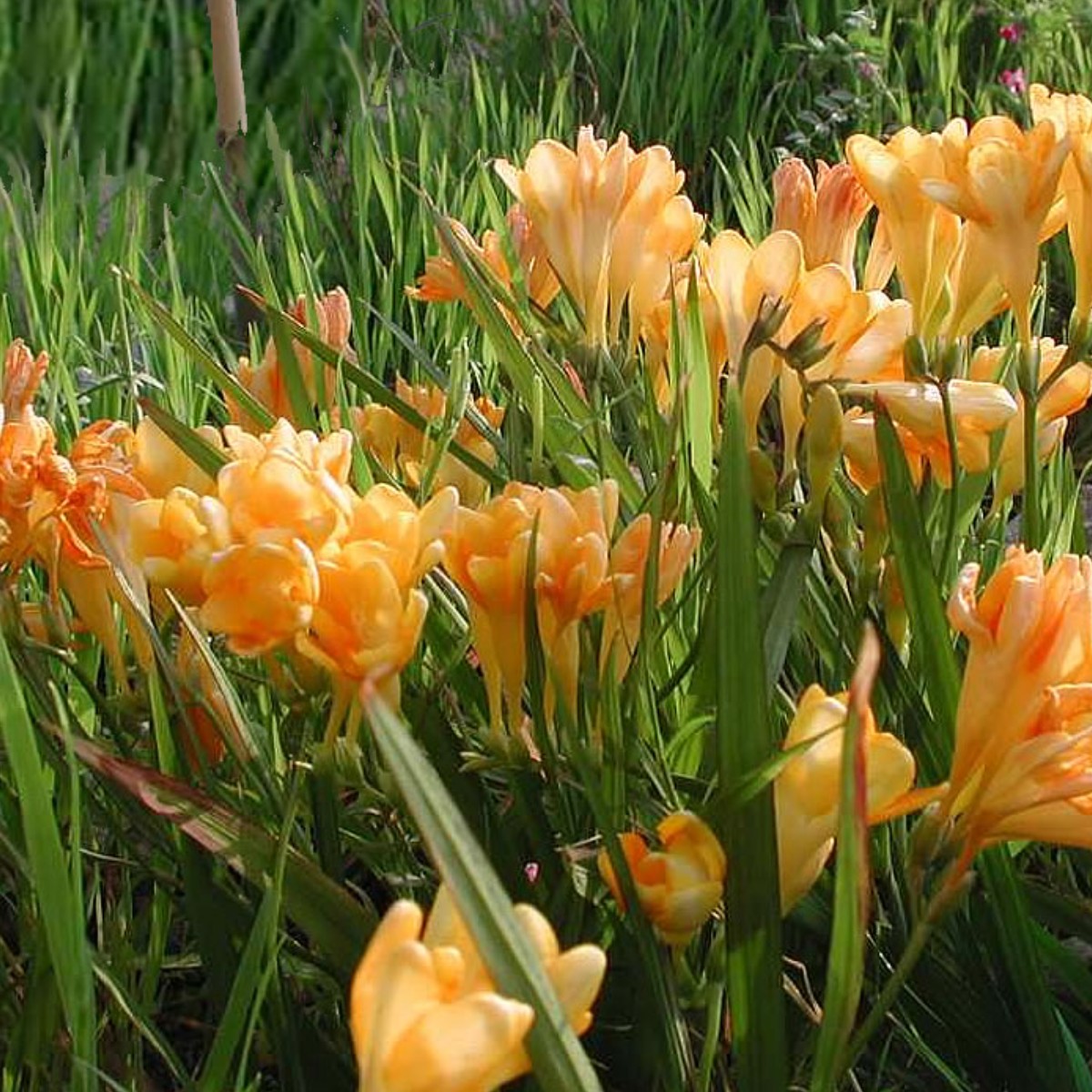Family: Iridaceae
Synonymous: Freesia hurlingii
Gladiolus refractus
Gladiolus resupinatus
Montbretia odorata
Montbretia refracta
Nymanina refracta
Tritonia refracta
Waitzia odorata
Waitzia refracta
Distribution and habitat: Freesia refracta is native to the the winter rainfall region of South Africa where it is found growing in sandy or stony soils amongst dune scrub or at forest edges, usually in light shade. It is a relatively common species of the dry interior valleys of the Western Cape. Freesia refracta was widely naturalised in mild climates being introduced as a garden plant.
Description: Freesia refracta are herbaceous plants which grow from a corm 12.5cm (0.4-1 inch) diameter, which sends up a tuft of narrow, strap-like leaves 1030cm (4-12 inch) long and a sparsely branched stem 1040cm (4-16 inch) tall bearing a few leaves and a loose one-sided spike of flowers with six tepals. They have fragrant narrowly funnel-shaped flowers that bloom facing upwards because their stems have the unusual habit of turning at right angles just below the bottom flower. This causes the upper portion of the stem to grow almost parallel with the ground. The flowers start to bloom in succession from the base to top of the inflorescence.
Freesia refracta flower is cream with a gold throat. This is the most sweetly scented and has cultivars in pink, red, purple, beige, gold and pure white.
Houseplant care: Freesia refracta corms are easy to force into bloom. Start planting freesia in late summer or early fall for winter or early-spring blooms.
After the flowers have faded, it is important to cut off the flower head but not the green stalk. Allow the foliage to die back naturally as the plant produce new offsets.
Light: Place Freesia refracta in bright light spot, but out of hot afternoon direct sun. This plant will appreciate some cool, direct morning sunlight.
Temperature: Keep Freesia refracta plants in cool room with temperatures ranging between 16-18C (60-65F) and moderate humidity while they are growing and flowering. Blooms will last for weeks if kept at a maximum of 18C (65F).
Freesia refracta plants need a mild winter temperature of around 10C (50F).
Water: Water well through the growing season but cut back during flowering time. Stop watering altogether once the foliage dies down and dries up. Do not overwater because it will cause the corms to rot.
Feeding: Feed the Freesia refracta plants every two weeks, beginning with the first show of flower buds till the end of flowering. Use a high-potassium liquid fertilizer diluted by half.
Potting and repotting: Choose a shallow pot (at least 8cm (3 inch) deep - approximate three times the height of the corm) with drainage holes in the bottom. Fill the pot loosely with potting mix. In early autumn, set Freesia refracta corms 5cm (2 inch) apart, pointed end up. Do not press the corms into the mix, keep the potting mixture loose so the roots can grow through it easily. Top corms with 2.5 cm (1 inch) of additional potting mix. Place the pot in a bright, warm location on temperature around 27C (80F) and keep the potting mixture barely moist until new growth appear in about 8 weeks. When shoots reach about 5cm (2 inch) tall, move the pot to a cooler room with about 16-18C (60-65F) in a bright window for a couple weeks until flower buds form. Turn the pot every couple days for even growth. When in full bloom, keep freesias in a bright location out of direct sun to prolong the bloom.
Freesia refracta corms will not bloom a second time indoors. They do produce offsets that can be planted. After flowering, allow the foliage to die back naturally, cut off the stems, then remove and store the offsets in a dry place. Alternatively, the clumps can be left in their container undisturbed for up to 3 years or until they become crowded when they should be divided in late summer. Freesia refracta will rest for a few months before beginning the next growing cycle in the spring.
Gardening: In zone 8 and colder, plant Freesia refracta in the spring rather than in autumn. These bulbs will not survive outside in regions colder than zone 9 as they are frost tender and need protection in very cold climates.
Location: Place Freesia refracta in a sunny location, preferably one that receives morning sun and afternoon shade for the strongest stems and best flower production.
Soil: Freesia refracta require planting sites that drain well. These plants do not thrive in soggy soil. Amend the soil with the addition of organic material to raise the soil level 5-8cm (2-3inch) for improved drainage. Peat moss, compost, ground bark or decomposed manure all work well and are widely available.
Dig holes and plant the corms 5cm (2 inch) deep and 8cm (3 inch) apart. Position the corms with the pointy end facing up. After planting, water well to settle the soil around the bulbs. Roots and sprints will form in a few weeks depending on soil and air temperatures.
After blooming has finished for the season leave the foliage in place; do not cut it off. The leaves will gather sunlight, create food through photosynthesis and strengthen the bulb for the future. In warm climates leave the bulb clumps undisturbed for up to 3 years or until they become crowded and then divide them in late summer. In colder areas, lift corms after the foliage dies down, store them over the winter and replant in spring when danger of frost is past.
Irrigation: Water well through the growing season but cut back during flowering time. Stop watering altogether once the foliage dies down and dries up.
Fertilising: A liquid fertiliser can be applied as soon as the first growth appears above ground.
Winter storage: Later in the summer the leaves will yellow and die back as the plant slips into dormancy. Foliage many be removed at this point. Freesia refracta will rest (remain dormant) for a few months before beginning the next growing cycle.
Cut off all remaining foliage and stalks after lifting. Discard all corms which appear diseased. Dust the corms with a fungicide and an insecticide. Pack them in wooden creates or cardboard boxes containing layers of dry wood shavings, sand or sawdust and store them in a sheltered place dried and with a minimum of 10C (50F). Plant the corms again as indicated above.
Propagation: Grow Freesia refracta from seed or corms planted in early autumn. It is preferable to purchase fat, thick corms in the autumn or early winter to plant them. Fresh seed germinates readily in 4 to 5 weeks. Some plants flower in their second season, most in their third. Freesia refracta is free-flowering, sets seed freely and seeds itself pretty freely too, and, with the production of cormels, a pot will be filled with plants in 2 to 3 years. Clumps are best lifted and divided every three years.
Problems: Protect Freesia refracta against aphids, mites and thrips as they can transmit viral diseases to which freesias are very susceptible.
Slugs and snails can also damage the leaves and a fungal dry rot attacks the corms.
Cutting flowers: Snip a few flowers for vase arrangements, as the plants will not be hurt. Freesia refracta flowers typically last 4 to 12 days, depending on their care, their maturity at the time of harvest and the environmental conditions in which they are displayed. If the buds on the lateral (branching) stems develop and open, the blooms generally will not be as large, be as colorful or last as long as the blooms on the main stem.
For best results, place Freesia refracta flowers immediately into a nutrient solution formulated especially for bulb flowers. Use a standard flower-food solution if a bulb-flower-specific solution is not available. Prepare the flower food solution with cold, non-fluoridated water. Fluoride can inhibit bloom development and opening and cause flower and leaf tip burn. Change the nutrient solution in vase every other day or so and check daily the water level. When changing the nutrient solution in vase, recut the stems at least 1cm (0.4 inch) to ensure effective water uptake. Also, protect these flowers from sources of ethylene gas emanated by ripening fruit, decaying flowers and foliage, automobile exhaust and tobacco smoke.
Display the Freesia refracta floral arrangement out of direct sunlight and away from air/heat vents. Remove florets as they fade. Mist blooms daily and place the flowers in the coolest room at night.
Purchasing list: Buy cut Freesia refracta when the first bud on each stem is just beginning to open and at least two additional buds are showing color. If the flowers are cut too tight, many buds may not open.
Check inflorescences, stems and leaves for bruising, browning, yellowing, mold and rot. Choose corms that are firm - not soft or mushy. Do not buy any corms that are sprouting.
Note: Freesia refracta is a species much used in hybridation.
The fragrance of Freesia refracta is incomparable in that it contains a cheerful bouquet of peppery zing and floral freshness projected at the right intensity, a delicious aroma that radiates for a long distance. High in linalool, a major component in all freesia varieties, it emits a refreshing, floral woody aroma with a subtle citrusy-terpenic note. But even within the species there are differences: the white flowers tend to smell more spicy, the colorful ones greener with the sweetness of crushed leaves and grass. The yellow flowered breeds "Gold Flame", "Aladdin" and "Rijnveld Golden Yellow" emit volatile compounds to abundance, while some others such as "Rose Marie", "Volcano" and "Bleu Heaven" are only noted for their flamboyant appearence rather than their scent.
Availability: Freesia refracta are sold as container plants, cut flowers and dormant bulbs for summer bedding.
Toxicity: All parts of the Freesia refracta are poisonous if ingested.
Uses and display: The flower stems habit of Freesia refracta make them lovely to look down into in a garden setting and ideal for arrangements. These plants are grown indoors in pots or in gardens in mild climates. In garden, Freesia refracta plants are attractive to bees, butterflies and birds. They look best in a massed display and are excellent cut flowers appreciated as long living vase flowers and for their fragrance. This plant is a great favourite for cottage gardens, borders or anywhere around the garden. It makes a wonderful pot plant that can be enjoyed on a sunny patio or sunk into the garden during its growing season or just for spring and removed and stored dry during summer or it can be grown permanently outdoors in pockets of the rock garden.
Height: 15-30cm (6-12 inch)
Hardiness zone 8a-11






